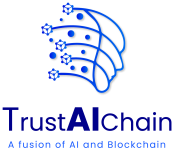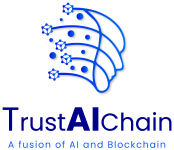The Scale of the Counterfeit Problem
The global counterfeit market is enormous, and the fashion industry is one of the hardest-hit sectors. According to a Global Brand Counterfeiting Report report (Certilogo), the fashion industry loses over $50 billion annually due to counterfeit products. Counterfeits diminish brand reputation and pose consumer risks by offering poor quality, unsafe materials, and substandard production processes.
Traditionally, the industry has relied on manual methods, such as visual inspections, barcodes, or RFID tags, to authenticate products, but these methods have significant limitations. The increasing sophistication of counterfeiters means that traditional verification methods are no longer enough. Enter AI and blockchain, two technologies poised to change the game.

How AI Can Detect Counterfeit Fashion Items
AI’s ability to process massive amounts of data and learn from patterns makes it an incredibly powerful tool in the fight against counterfeits. Here’s how AI is making a difference:
- AI-Powered Image Recognition
Artificial intelligence, specifically machine learning models, can be trained to recognize minute details in fashion products. AI-powered image recognition tools can analyze various characteristics of an item, such as stitching patterns, logos, and materials, and compare them against a database of authenticated items. This level of precision is nearly impossible for human eyes to achieve, but AI can quickly spot subtle differences between an authentic product and a counterfeit.
For example, companies like Entrupy have developed AI-based solutions that allow retailers and consumers to use smartphones to authenticate luxury goods. The software scans the product and instantly determines authenticity based on its vast database of images and product details. This type of real-time validation helps prevent counterfeit items from entering the market at various stages, from production to retail.
2. AI for Predictive Analytics
AI’s predictive analytics capabilities are being leveraged to forecast potential counterfeit trends. AI can identify suspicious activity by analyzing historical data, consumer behaviors, and purchase patterns. For example, a sudden spike in sales of a particular designer brand on e-commerce platforms may raise red flags about the authenticity of those products.
Additionally, AI can scan online marketplaces and social media platforms, detecting counterfeit listings before they reach consumers. By flagging suspicious sellers and products, AI helps prevent the proliferation of counterfeits across digital channels.
- Natural Language Processing (NLP) for Tracking Counterfeit Sellers
AI, using NLP, can analyze text on online marketplaces and social media platforms. It can identify listings with telltale signs of counterfeit products, such as unusual descriptions, price discrepancies, or vague seller details. By continuously scanning and monitoring platforms, AI helps brands and retailers quickly identify and take down counterfeit listings.
The Role of Blockchain in Ensuring Authenticity
While AI is excellent for detection, blockchain brings transparency, traceability, and immutability to the fashion supply chain. Blockchain technology can provide consumers and brands with an immutable ledger of a product’s journey from production to sale, ensuring its authenticity is verifiable at every step.

- Blockchain for Supply Chain Transparency
Blockchain’s decentralized and tamper-proof nature allows for transparent record-keeping at every product lifecycle stage. From raw material sourcing to final delivery, each step can be recorded on a blockchain, ensuring a product’s authenticity. Consumers can easily verify an item’s origins and manufacturing details by scanning a QR code or using an app linked to the blockchain.
For instance, a high-end handbag can have its entire production process recorded on the blockchain: the origin of its leather, the location of its assembly, quality control checks, and even its shipping details. Once the data is entered, it cannot be altered, ensuring the product’s history is accessible and trustworthy.
Luxury fashion brands such as Louis Vuitton and Prada are already exploring blockchain solutions to trace the authenticity of their products. LVMH, the parent company of several luxury brands, has launched the AURA blockchain platform, allowing consumers to verify their products’ authenticity by scanning a unique digital certificate attached to the product.
- Smart Contracts for Secure Transactions
Blockchain’s smart contracts can further strengthen authenticity by automating the verification process. A smart contract is a self-executing contract with the terms of the agreement directly written into code. For example, when a consumer purchases a designer item, a smart contract could be triggered to verify the product’s blockchain record automatically, ensuring its authenticity before the transaction. This automated process eliminates the need for third-party verification services and reduces the risk of counterfeit products being sold through fraudulent transactions. Furthermore, smart contracts can authenticate ownership, preventing resellers from selling fake products as second-hand originals.
- NFTs for Digital Proof of Ownership
Non-fungible tokens (NFTs) are also gaining traction in the fashion industry as a digital solution for proving ownership of luxury goods. When a consumer purchases a physical fashion item, they can also receive a corresponding NFT as proof of ownership stored on the blockchain. This digital certificate can be transferred with the item when resold, ensuring the new owner can verify the product’s authenticity and provenance.
This concept is particularly valuable in the resale market, where counterfeits are rampant. NFT ownership certificates create a digital paper trail that guarantees the authenticity of a product across multiple owners.

Combining AI and Blockchain for Comprehensive Anti-Counterfeit Solutions
While AI and blockchain are powerful tools, their combined use can offer a comprehensive solution to the counterfeit problem in fashion.
Imagine a future where AI and blockchain work together seamlessly: a consumer purchases a luxury handbag online, and an AI-powered tool instantly verifies the product’s image against a database of authenticated items. Simultaneously, the product’s blockchain record is accessed, providing a detailed history of its manufacturing process, raw materials, and ownership. The consumer receives the handbag and a corresponding NFT as proof of authenticity, ensuring that the item retains its verified status throughout its lifecycle.
In this scenario, the fashion industry gains a robust anti-counterfeit system that is both preventative and reactive. AI detects potential counterfeits before they reach consumers, while blockchain ensures that all legitimate products have a transparent, immutable record of authenticity.
Challenges and Future Prospects
While the potential of AI and blockchain in combating fashion counterfeits is immense, there are still challenges to overcome. Implementing blockchain across global supply chains can be costly and complex, especially for smaller brands. Additionally, integrating AI-powered solutions requires training models on vast datasets, which can be time-consuming.
However, as these technologies evolve and become more accessible, the fashion industry will likely see a significant reduction in counterfeiting. Governments, brands, and technology companies already invest in AI and blockchain solutions, recognizing their potential to reshape fashion’s authenticity landscape.

In Summary
The fight against counterfeit fashion is entering a new era, powered by the combined forces of AI and blockchain. With AI’s ability to detect counterfeits in real time and blockchain’s capacity for creating transparent, tamper-proof supply chains, the fashion industry is poised to tackle counterfeiting more effectively than ever.
As these technologies advance, consumers will gain confidence in the authenticity of the products they purchase, and brands will regain control over their intellectual property. Shortly, counterfeiting could be a relic of the past, replaced by a new age of transparent, secure, and authentic fashion experiences.







